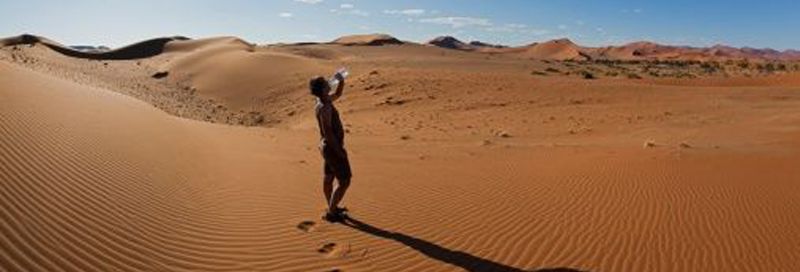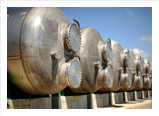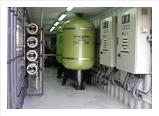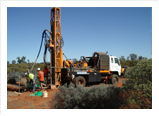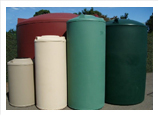FAQs
How can the various processes of separation help me maximise my water?
The advancement of membrane processes over the past ten years has resulted in an economically viable drinking water treatment solution for both large- and small-scale applications. The following shows the typical applications of various filtration methods.
Households
Rainwater can be collected from storm drains and be purified with reverse osmosis water processors. This water can then be used for landscape irrigation and industrial cooling.
Power Plants
Reverse osmosis removes minerals from boiler water at power plants to ensure that the water doesn’t cause corrosion or damage to the machinery, which would reduce efficiency. Moreover, reverse osmosis plant membrane systems typically use less energy than thermal distillation.
Reverse osmosis is also used to clean effluent and brackish groundwater. The effluent in larger volumes (more than 500 cu. meters per day) should be treated in an effluent treatment plant first, and then the clear effluent is subjected to reverse osmosis system. Treatment cost is reduced significantly and membrane life of the RO system is increased.
Medical Industry
Reverse osmosis is similar to the technique used in dialysis, which is used to treat renal kidney failure. The kidneys filter the blood, removing waste products (e.g. urea) and water, which is then excreted as urine. A dialysis machine mimics the function of the kidneys. The blood passes from the body via a catheter to the dialysis machine, across a filter that removes the wastes, and then reinters the body.
Food & Beverage Industry
In addition to desalination, reverse osmosis is a more economical operation for concentrating food liquids (such as fruit juices) than conventional heat-treatment processes. Its advantages include a lower operating cost and the ability to avoid heat-treatment processes, making it suitable for heat-sensitive substances like the protein and enzymes found in most food products.
Dairy Farming
Reverse osmosis is extensively used in the dairy industry for the production of whey protein powders and for the concentration of milk in order to reduce shipping costs. In whey applications, the whey (liquid remaining after cheese manufacture) is concentrated with reverse osmosis from 6% total solids to 10-20% total solids before UF (ultrafiltration) processing. The UF retentate can then be used to make various whey powders, including whey protein isolate used in bodybuilding formulations. Additionally, the UF permeate, which contains lactose, is concentrated by RO from 5% total solids to 18–22% total solids to reduce crystallization and drying costs of the lactose powder.
Car Washing
Because of its lower mineral content, reverse osmosis water is often used in car washes during the final vehicle rinse to prevent water spotting on the vehicle. Reverse osmosis water displaces the mineral-heavy reclamation water (municipal water). Reverse osmosis water also enables the car wash operators to reduce the demands on the vehicle drying equipment, such as air blowers.
Is recycled water safe?
Recycled water quality depends on a number of factors, including:
• whether the sewage has come from industrial or domestic sources or a combination of both
• the quality of the raw sewage and what controls are in place to maintain and protect sewers and;
• the level and type of treatment undertaken
The quality of recycled water must be suitable for its intended use. Factors to consider include:
• the microbiological quality of recycled water
• nutrients (how many nutrients are in the water)
• salinity (how much total dissolved solids are in the water)
• other water quality requirements specific to each end use
Recycled water is very safe when guidelines are followed and it is used for the intended purpose. In Victoria, the EPA has set guidelines for using recycled water to protect human health and the environment. Victorian regulation has grouped recycled water into ‘classes’, based on its microbiological and physical quality.
For more information visit www.epa.vic.gov.au
Regular monitoring and reporting is required to ensure the quality of water being supplied is fit for use.
What is a bore?
A bore consists of pipes(casing) extending into the groundthrough which groundwater is drawnfrom an underground layer of water-bearing permeable rock (the aquifer) to the surface. Thecasing supports the walls and preventsrocks and debris collapsing the boreand contamination by surface runoff.
In some small bores thepump is connected directly to the top of the bore casing or to a suction pipeinside the bore.
What is desalination?
Desalination refers to several processes that remove excess salt and other minerals from water. Processes of separation include reverse osmosis, nanofiltration, ultrafiltration, microfiltration and particle filtration. Each process differs according to the size of material that it can identify and remove.
Water is desalinated in order to convert salt water to fresh water so it is suitable for human consumption or irrigation. Sometimes the process produces table salt as a by-product.
Membrane water treatment systems are part of the desalination process. Water treatment membranes are thin sheets of material that are able to separate contaminants based on properties such as size or charge. Water passes through a membrane and larger particles, microorganisms, and other contaminants are separated out.
What is recycled water?
Recycled water is water taken from any waste stream and treated to a high standard so it can be used for a new activity. ‘Recycled water’ generally refers to fully treated effluent (out flowing of water from a natural body of water)from sewage treatment plants.
Recycled water is a secure alternative source that, when treated as required, is fit for a range of purposes, such as:
- agricultural irrigation
- industrial processing such as for cooling
- municipal uses such as watering parks and gardens
- domestic uses such as toilet flushing, car washing, and garden watering
Currently about 28.9% of Melbourne’s sewage is recycled and used for a range of activities, according to Melbourne Water. For more information visit www.melbournewater.com.au
What is reverse osmosis?
Reverse osmosis (RO) is a filtration method that removes many types of large molecules and ions from solutions (typically water) by applying pressure to the water when it is on one side of a selective membrane. The result is that the solute (the excess salt and minerals) is retained on the pressurized side of the membrane and the pure solvent is allowed to pass to the other side.
The process is similar to other filtration processes, such asnanofiltration and ultrafiltration. However, there are key differences – the predominant removal mechanism in membrane filtration is straining, or size exclusion, so the process can theoretically achieve perfect exclusion of particles regardless of operational parameters such as influent pressure and concentration. Reverse osmosis, however involves a diffusive mechanism so that separation efficiency is dependent on solute concentration, pressure and water flux rate.


